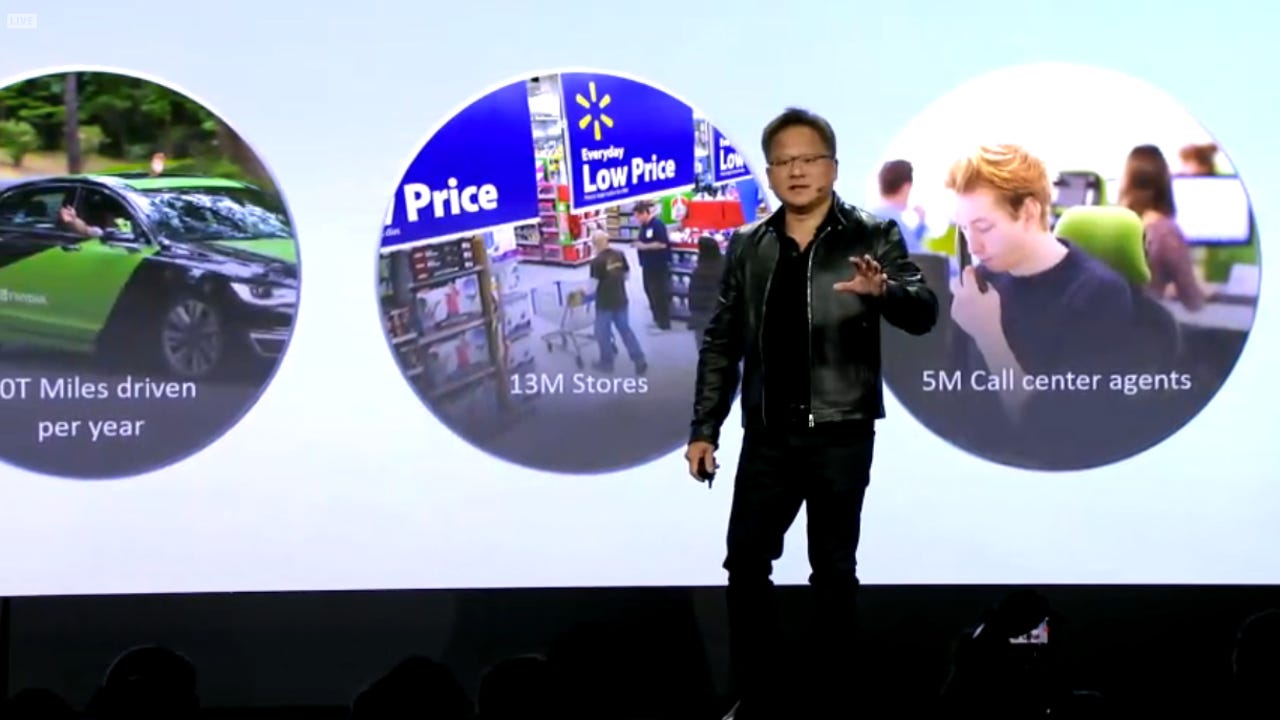Nvidia's cloud-native EGX Edge Supercomputing Platform for AI, IoT, 5G


Nvidia lifted the lid off its Nvidia EGX Edge Supercomputing Platform during Mobile World Congress (MWC) in Los Angeles on Monday, which the company touted would act as a high-performance, cloud-native platform to make use of the increasing amount of data that is being gathered by organisations.
"EGX is a reference platform where we are testing and validating servers to be able to run high-performance AI through many different global OEMs and ODMs and building a software stack to make it easier to deploy artificial intelligence applications at the edge," Nvidia GM of enterprise and edge computing Justin Boitano said, speaking with media about the new offering.
SEE: 5G: What it means for IoT (ZDNet/TechRepublic special feature) | Download the free PDF version (TechRepublic)
Making the announcement during his MWC keynote on Monday, Nvidia founder and CEO Jensen Huang said the EGX Edge Supercomputing Platform would allow organisations to harness rapidly streaming data from factory floors, manufacturing inspection lines, and city streets to securely deliver next-generation artificial intelligence (AI), Internet of Things (IoT), and 5G-based services at scale, and with low latency.
"We've entered a new era, where billions of always-on IoT sensors will be connected by 5G and processed by AI," Huang said. "Its foundation requires a new class of highly secure, networked computers operated with ease from far away.
"We've created the Nvidia EGX Edge Supercomputing Platform for this world, where computing moves beyond personal and beyond the cloud to operate at planetary scale.
"We finally have the necessary technology to engage."
EGX was unveiled in May, with the platform combining Nvidia's AI technologies with security, storage, and networking technologies from Mellanox.
See also: Nvidia's purchase of Mellanox turns up heat on Intel rivalry, data center ambitions
The platform's software stack, Nvidia Edge Stack, is optimised for real-time AI services like vision, speech, and analytics, as well as Red Hat OpenShift for Kubernetes container orchestration.
The Edge Supercomputing Platform combines Nvidia CUDA-X software with Nvidia-certified GPU servers and devices, Huang said. The EGX platform supports Nvidia Metropolis, which can be used to build smart cities and intelligent video analytics applications.
It can also support the new Nvidia Aerial software developer kit, also announced during Huang's keynote.
According to Huang, the critical element that will allow 5G providers to move to cloud-native infrastructure is Nvidia Aerial. The software developer kit allows providers to build and deliver high-performance, software-defined 5G wireless RAN by delivering two essential advancements: A low-latency data path directly from Mellanox network interface cards to GPU memory and a 5G physical layer signal-processing engine that keeps all data within the GPU's high-performance memory.
Aerial, Huang continued, allows telcos to build completely virtualised 5G radio access networks that open up possibilities to services such as smart factories, AR/VR, and cloud gaming.
The Nvidia Aerial SDK, running on the Nvidia EGX stack, brings GPU acceleration to carrier-grade Kubernetes infrastructure. The EGX stack includes an Nvidia driver, Nvidia Kubernetes plug-in, Nvidia Container runtime plug-in, and Nvidia GPU monitoring software.
See also: Medical imaging at the 'speed of light': Nvidia's Clara supercomputer
Huang also touched on early adopters of the EGX Edge Supercomputing Platform, which include Walmart, BMW, Procter & Gamble, Samsung Electronics, and NTT East, as well as the cities of San Francisco and Las Vegas.
"At Walmart, we're using AI to define the future of retail and re-think how technology can further enhance how we operate our stores," Walmart Intelligent Retail Lab CEO Mike Hanrahan said in a statement. "With Nvidia's EGX edge computing platform, Walmart's Intelligent Retail Lab is able to bring real-time AI compute to our store, automate processes, and free up our associates to create a better and more convenient shopping experience for our customers."
His organisation has deployed EGX in its New York-based lab, with Walmart exploring ways for AI to further improve in-store shopping experiences.
Using EGX, Walmart said it could compute more than 1.6 terabytes of data generated each second in real time. It's using AI to alert staff to perform tasks such as shelf re-stocking, open up new checkout lanes, retrieve shopping carts, and determine produce freshness.
BMW is using intelligent video analytics in its South Carolina manufacturing facility to automate inspection, using EGX to gather data from multiple cameras and other sensors in inspection lines.
While the city of Las Vegas is using EGX to capture vehicle and pedestrian data in a bid to make its streets safer; it also plans to use the data to autonomously manage signal timing and other operational capabilities.
Also announced on Monday afternoon was the new Nvidia CloudXR SDK, which will allow organisations to create and deliver high-quality, wireless AR and VR experiences from any application based on OpenVR.
The SDK runs on Nvidia servers located in the cloud or on-premises data centres, delivering the advanced graphics performance needed for wireless virtual, augmented, or mixed reality environments, Huang said.
Companies that have their own 5G networks can use Nvidia CloudXR to stream immersive environments from their on-premises data centres
Enterprises can now deliver virtual and augmented reality experiences across 5G networks to any device with NVIDIA CloudXR.
Following on from the EGX and Arial announcements, Nvidia doubled down on its move into 5G, partnering with Ericsson, Red Hat, and Microsoft, with a spotlight on the telecommunications industry.
SEE MORE
- Nvidia looking to surf data science wave into the data center
- Nvidia claims world records in conversational AI training
- Nvidia beats Q2 expectations, achieves record automotive sales
- Nvidia Research demos "Prescription AR" glasses
- Nvidia announces 10 new RTX Studio laptops and mobile workstations
- Nvidia unveils GeForce RTX SUPER gaming GPUs